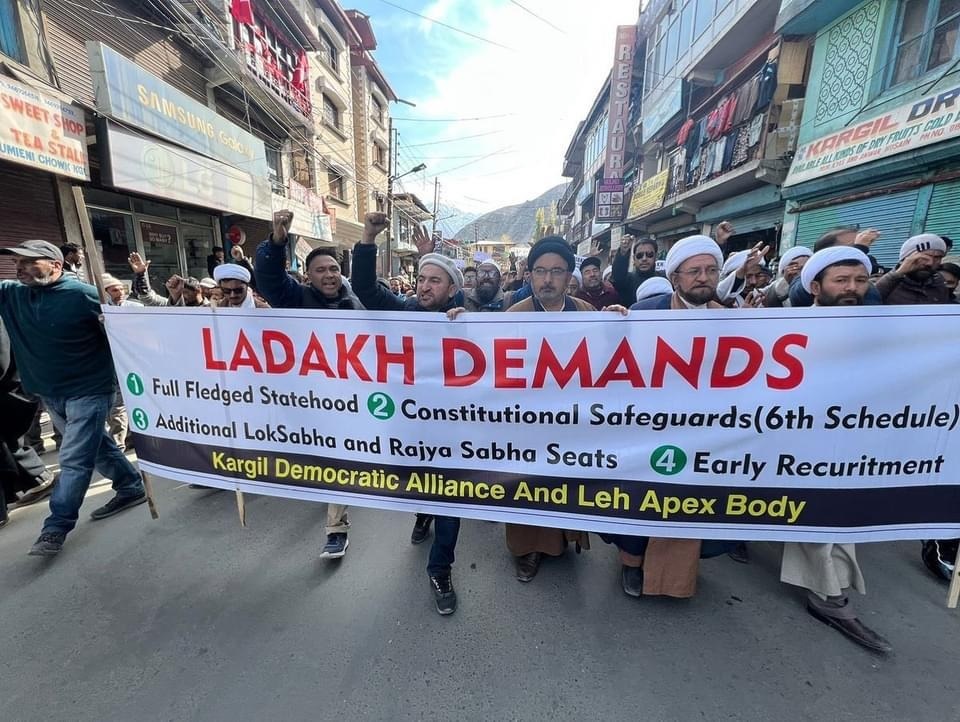
As the climate activist Sonam Wangchuk observes fast unto death as part of his struggle for constitutional rights for his people, the irony of his protest hasn’t been lost on anyone. In 2019, Wangchuk was at the forefront of the activists in Leh, who celebrated the withdrawal of Article 370 and the granting of union territory status to Ladakh. In a tweet, Wangchuk then thanked the prime minister Narendra Modi “for fulfilling Ladakh’s longstanding dream,” and termed the far-reaching constitutional changes as a step towards “democratic decentralization.”
Since then, he has grown increasingly disillusioned with Ladakh’s UT status and come to a conclusion that the region was better off with being a part of Jammu and Kashmir,” something he told the media last year. And now his fast, second since last year, shows that Wangchuk has moved 180 degrees from his 2019 position. Not just him but also the people of the Leh district while those in the neighbouring Kargil had largely opposed the UT status from the day one.
The two districts have now closed ranks and are jointly fighting for the constitutional protections for Ladakh. The Leh Apex Body (LAB) and Kargil Democratic Alliance (KDA) which are spearheading the agitation, are demanding special rights and statehood for Ladakh. It is the first time in decades, the two Ladakh districts have been on the same page in pressing the union government to fulfill their demands.
In the new scheme of things, the democratically elected Ladakh Hill Development Councils (LAHDCs), both of Leh and Muslim majority Kargil, which acted autonomously in undivided J&K have become redundant. The region is now directly ruled by the centre through a Lieutenant Governor. So, LAHDCs effectively mean little for regional empowerment. The current Ladakhi struggle is thus born of a deep sense of loss.
However, the struggle has so far achieved little. The centre has largely cold-shouldered Ladakhi leaders but the latter too have not backed down. Ladakhi demands have only grown in number. The LAB and KDA now seek tribal status for Ladakh, statehood, inclusion in the constitution’s Sixth Schedule, job reservation for locals, and a parliamentary seat each for the Leh and Kargil districts. They are citing the cases of Mizoram, Tripura and Sikkim which are protected by special constitutional provisions.
Wangchuk has explained the significance of the Sixth Schedule, emphasizing its requirement for consulting local indigenous people on any agenda. The provision entails the establishment of councils with legislative and lawmaking rights, ensuring that industries can operate only with the consent of the local population.
Last year, the Ladakh Tourist Trade Alliance (LTTA), a coalition of trade, tourism, religious, and political organizations in Leh, passed a resolution opposing investment by outsiders in the tourism sector of Ladakh. The alliance warned that if such investments continue, they would impose restrictions on these investors through non-cooperation from the local travel trade fraternity, as well as from the community and political organizations.
Where do we go from here? Nowhere in the near future. More so, until the new government is formed at the centre. And should the BJP return to power with a landslide mandate as looks likely, it may do little to address Ladakhi demands. Meanwhile, the Ladakhi agitation is likely to continue. People in the region have developed a deep sense of existential crisis: they apprehend an inevitable change in demography and takeover of their land, jobs and resources in the absence of credible constitutional protections. Exacerbating this fear among the people of the region is their small population which has bred a fear of a rapid demographic change, in case the outsiders aren’t constitutionally barred from settling in the region.
The total population of Ladakh, according to the 2011 census, is 2.74 lakh. While Leh with a population of 1,33,487 is Buddhist majority, Kargil with a population of 1,40,802 is Muslim majority. Overall, Ladakh has a slim Muslim majority. But this hasn’t prevented the two communities who in the past were at daggers drawn to come together.
This has created a difficult situation for the union government. It can’t be seen extending constitutional safeguards to Ladakh and denying the same to Jammu and Kashmir where similar anxieties about identity and culture prevail – albeit, currently in a dormant state. The agitation in Ladakh has thus come as a moment of reckoning for New Delhi.
At the same time, it is crucial for the union government to work towards a solution that ensures Ladakh’s constitutional rights and preserves their cultural identity. The demand for tribal status, inclusion in the Sixth Schedule is not extraneous but a rightful claim that deserves attention and consideration. As Ladakh faces economic and political challenges in the aftermath of the constitutional changes, it is imperative to find a middle ground that respects the region’s unique circumstances.
- Views expressed in the article are the author’s own and do not necessarily represent the editorial stance of Kashmir Observer
Follow this link to join our WhatsApp group: Join Now
Be Part of Quality Journalism |
Quality journalism takes a lot of time, money and hard work to produce and despite all the hardships we still do it. Our reporters and editors are working overtime in Kashmir and beyond to cover what you care about, break big stories, and expose injustices that can change lives. Today more people are reading Kashmir Observer than ever, but only a handful are paying while advertising revenues are falling fast. |
| ACT NOW |
| MONTHLY | Rs 100 | |
| YEARLY | Rs 1000 | |
| LIFETIME | Rs 10000 | |











